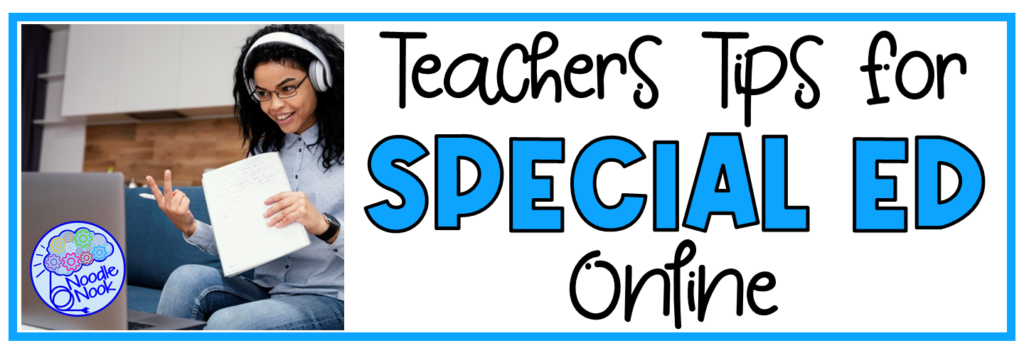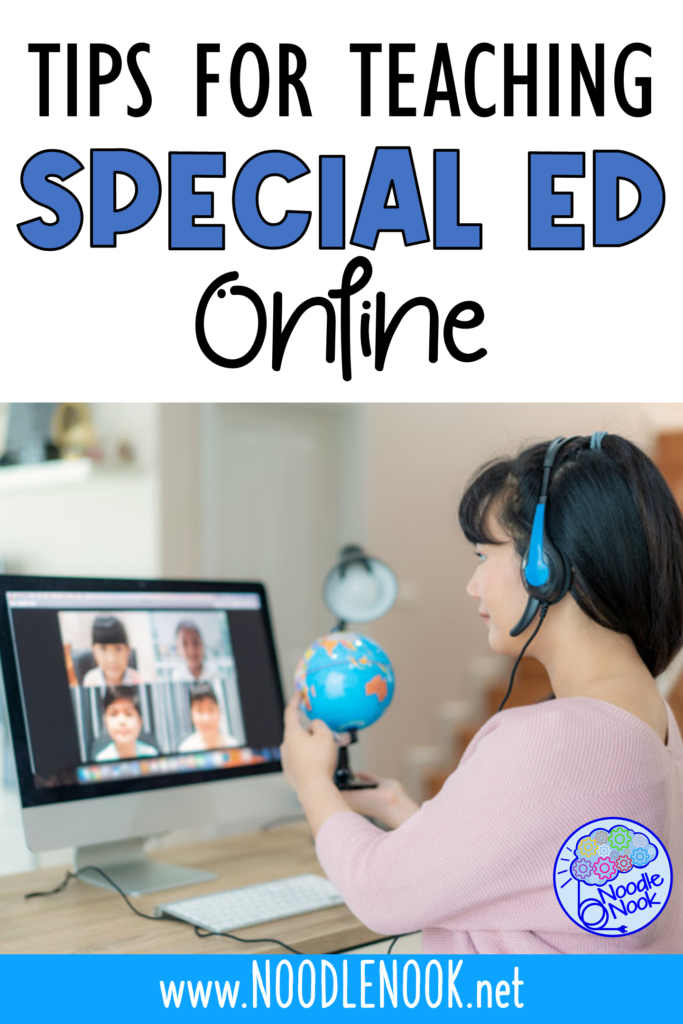What started out as an extended spring break has turned into an extended amount of time out of the classroom. Everyone’s lives have been spun around with mass school closures. At first, we prepared for a couple of weeks out of school. Now it seems we may not return at all this year. Finding a meaningful way of supporting special needs students online can be a real challenge for both parents and teachers. So, if you’re spinning your wheels trying to figure out how to teach special ed online, here are some suggestions.
1. Actually Connect
My 5th grader has been hopping on Zoom to connect with his teacher and his classmates a couple of times a week. That’s all well and good for most neurotypical kids. When your students have severe and profound disabilities, however, hopping on Zoom is likely out of the question.
The only problem is this isolation then impacts those students more. They need social interaction just as much as the next person. If you were back on campus, how would you accommodate a special ed student who was having a hard time with whole class instruction? You would use repeat/review, notes, and small groups! So, instead of trying to schedule an entire class Zoom try a couple of alternatives.
Small Group Zooms
First, if you can, schedule some small group Zooms with leveled peers or social groups. This will allow more processing time, and more meaningful interactions, and you will still be able to guide the groups as you connect. If you want to work in some academics, then go for it. And these do not have to be hour-long power sessions. Plan on 15 minutes. It’s just to break up the isolation.
Record A Lesson
Second, if video conferencing is not an option, then try to record yourself reading a book or story and share the link with parents. You will get to reuse the materials and students will get to see your face and hear your voice. Add in a few seconds of wait time after you ask a question. Then a parent working with a child can pause the video and initiate interaction. For students with the most severe disabilities, suggest some props a parent can use while you read. That could be a stuffed animal while you read about dogs or a wet washcloth while you read about oceans. Parents can help connect the student to you as you read.
Flip Your Lessons
Third, it may be time to explore flipping your lessons. Provide parents with a video of you reading a lesson or presenting materials that they can access at their leisure. Try using Loom so you can record the screen and you at the same time. I actually love Loom (no affiliate marketing here). Then, schedule a time when you can engage with the student in a small group or one-on-one. By doing this, you will minimize the time on task for the ‘in-person’ session. For so many of our students, attention spans are short. Asking for a student to sit through the instruction and the interventional lesson is a big ask. It is also taxing on the parent. They may have other kids who need to get online, work obligations, or spotty connectivity. All three of these tips will help you connect as you teach special ed online.
2. Break from the Velcro Tasks
It is okay to admit that, as a special ed teacher, you have a set of tasks that you use… a lot. We sped teachers love the smell of lamination. We feel a rush of joy when Amazon delivers our bulk order of Velcro. At home, though, our parents are more concerned with Amazon dropping off groceries, not Velcro dots. Asking them to reproduce your favorite activities is not realistic and, quite honestly, could be quite burdensome. So what are some alternative tasks your students can do at home if, in the classroom, they’ve been getting a lot of support and tasks?
Try using predictive templates with a variety of materials. It’s easy to bust out a file folder activity as a companion tool to a book your class is reading. It gives your students some hands-on activities while still engaging in what the rest of the class is working on. Now, that same file folder activity may not be a possibility. That doesn’t mean that you have to break with predictive templates that your students can access in its place.
My go-to is graphic organizers!
No matter what reading materials are in front of them, students can work on who, what, where, when, and why. Maybe cause and effect is better for some kiddos or during Science class. Whatever graphic organizer you like, find one that best meets the skillset of your student. Then provide that one sheeter to parents. Now they can use it with a multitude of reading materials and even online resources. (Read more about Graphic Organizers here.) Now your student is mastering the analysis of the materials and not being bogged down with the process. If you then need to provide added materials as a companion, whip up connection icons. Add images for who, what, where, when, and why in an easily printable page for the stories that week. That makes it easy on the parents and on you too!
Second, try some predictive tasks that go along with easy items to find at home. Every week I get a Mac truck delivery of store flyers in my mailbox. Knowing that parents can easily access an item like this, create a task just for them! I have a Grocery Store Flyer activity focused on improving shopping skills. If you’re a math teacher, create a grocery store flyer task that incorporates the skills you’re targeting with these fresh sets of flyers that a parent gets every week. I have already brainstormed a list of a dozen math activities you can pair with a grocery flyer. Check out that post here. It’s a great way to make a predictive task with what is easily available for a parent. Break your lamination addiction!
3. Remember Communication is KING!
Okay… you know what I am about to say is the honest truth. It takes eons to build good communication skills with students who have significant disabilities. Oftentimes we work all the way from elementary through high school to create an effective way for students to communicate. Extensive time outside of the classroom, like during this school closure, means significant regression.
While schools are closed, we have to figure out a way to effectively work on communication skills in a meaningful and functional fashion. I’ve said this a million times. The only way for a student to master a communication system, whether that be a VOD or low-tech core board, is to see it modeled by the adults around them and be forced to interact with it on a frequent daily basis. Fortunately, that can be a big ask for parents at home. It might not be a fight they are willing to have.
On top of that, many of our students don’t have access to their voice output device or communication system because it’s locked up in a classroom somewhere. So, as our students’ best advocate, we have to figure out a workaround to get them to communicate with the people around them. If you don’t have a paper core board to share with parents who are without electronic systems right now, get one! Find one that you think would work best for your students. Then get it in their hands as fast as possible. Seriously, communication regression is real! You can check this one out in the Noodle Nook store in both a digital and paper copy.
Once your students have access to a communication system, we have to provide guidance to the parents. They need to know how to interact with that system and their child and also how often it needs to happen. In addition, schedule some video conferences with your students. Use one on one or small groups so that you can practice in real-time. We cannot neglect communication while at home learning… the consequences are too severe. I offer parents some advice on increasing communication opportunities in a post on at-home learning for students with disabilities. You can read more about those suggestions here. Offer those tips to parents so they can also increase the amount of meaningful time their child spends working on communication.
4. Provide STRATEGIES!
It is easy to get caught up in the academics of at-home learning. What seems to be going under the radar as special education teachers figure out how to teach special ed online are the strategies we use to support students every day.
Things like wait time, effective use of visuals, structuring the physical environment, and strategies for before a behavior occurs are all things we’ve studied over time. Our parents, however, might not be equipped to do this now that they are playing the role of ‘teacher’. more importantly, the longer our students go without these strategies in place, the more difficult it will be when school starts back up again. We kill ourselves in routine and procedures at the beginning of every school year… we don’t want it to get worse because our students have been out of the classroom so much longer this time.
Think about a strategy that you can provide parents on a weekly basis that is pertinent to their child or their classroom setting. If you can make a video to model that behavior, that’s great! Maybe you can share a YouTube video that is full of tips and examples of the strategy you’re targeting. The big thing is our parents need a little bit of training. They’re taking on a task they’ve never done before, that of their child’s primary teacher. It’s a different gig altogether! Our parents need those extra supports and, if they’re going to get them, we’re going to be the ones to provide them.
As a special education teacher, I would target things like wait time, first then charts, antecedents for behavior, or how to use a token board. It really doesn’t matter what you pick, just provide some strategic support! It will be worth its weight in gold when school starts back again.
5. Be a Cheerleader!
Okay. Time to dive into the feels. We have parents out there who feel like they’re failing their kids because they’re having a hard time dealing with the emotional toll of this extended closure. They’re dealing with the financial reality of either being out of work or working with fewer hours. They are working through how to homeschool their child with significant disabilities and work remotely from home too. They’re having to learn how to cope with being their child’s sole touchstone with no break. For some of our parents, this long stretch of time alone with their child with no support staff, respite care, or break is a burden. And there’s a lot of guilt with feeling that way.
Right now, we all need a little bit of cheerleading. We’re working outside of our comfort zone, dealing with things that we’ve never had to think through in the past. We’re all struggling with some peace of this extended isolation, but no one more so than a parent of a special needs child. There is no parenting manual, and there is definitely no manual on how to teach special ed online as a parent. Take a moment to think about how you’re going to support parents as well as students. Because they both need to hear that they’re doing a good job.
Be sure to share the sister post to this one all about Online Learning for Parents.
Wrapping It Up
Okay, there you have it… 5 tips as you work through how to teach special ed online. One last thing before you go.
You are AMAZING!
I have seen teachers shine and really go all out for their students as well as all figure out how to teach special ed online. Online teaching has a steep learning curve and implementing it with special needs students with zero notice and minimal guidance as so many of you have done is inspiring. You are what keeps our students growing and improving without due recognition, compensation, or respect. I just want you to know, you’re doing a great job.
Stay strong and teach on!

CONNECT
Pinterest Instagram Facebook Twitter YouTube iTunes
Tips, tricks, resources, and FREE tools for teachers in Special Ed and Autism Units. Listen, read and watch to learn how to be more successful at Noodle Nook. And be sure to subscribe to the monthly newsletter TODAY!
Article Citation: [cite]





